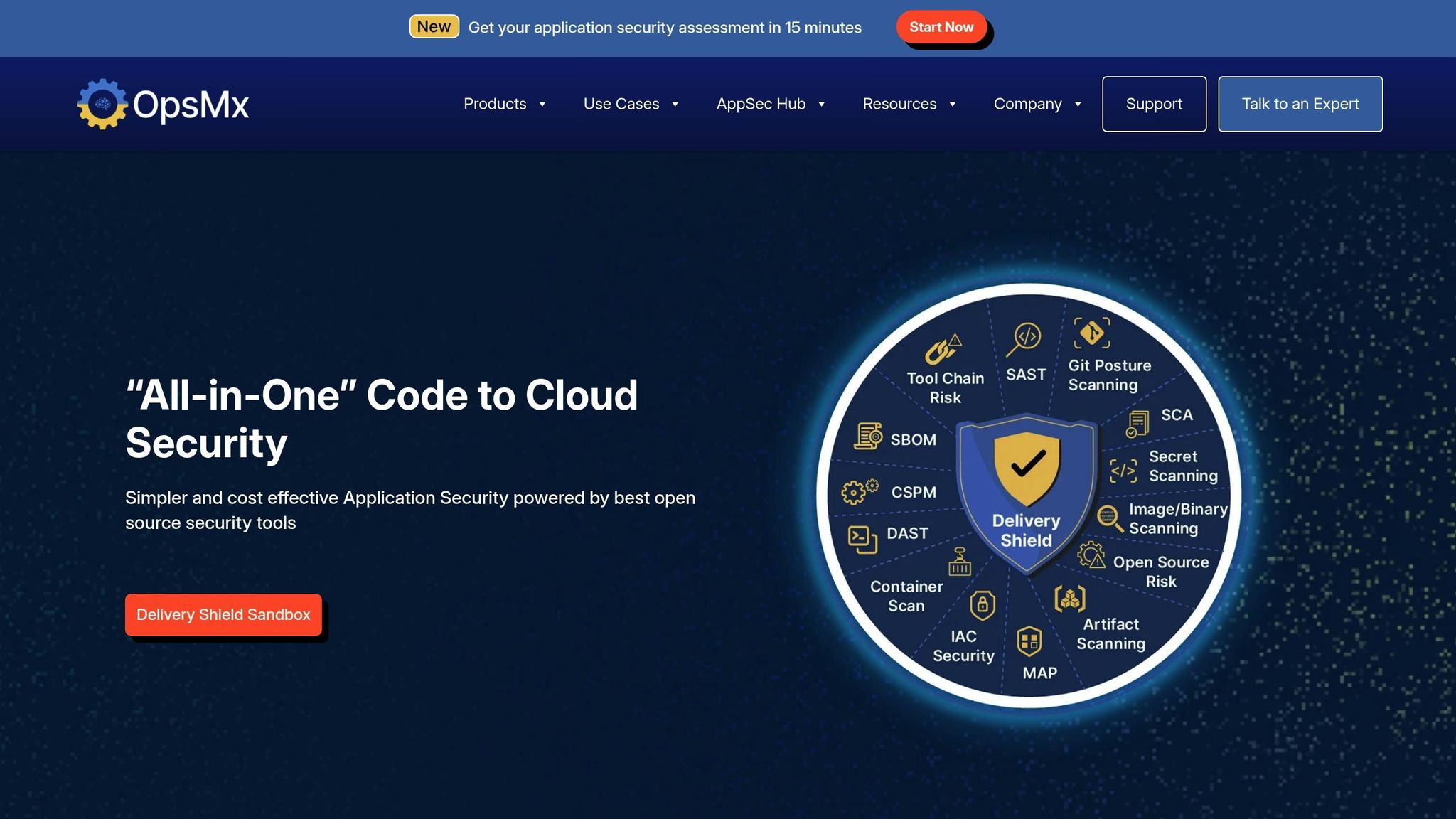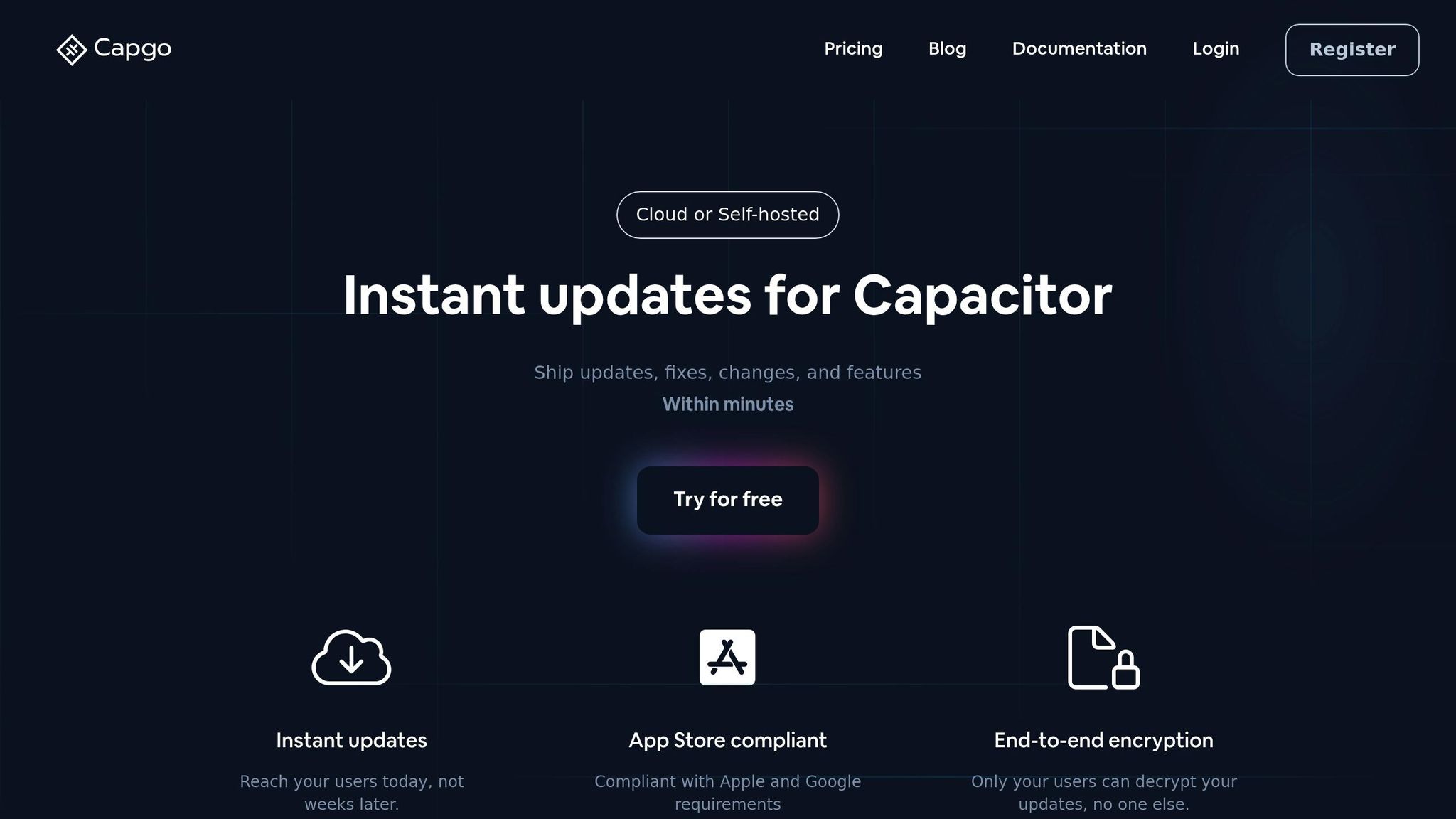CI/CD workflows make apps safer by automating security checks and speeding up fixes. Traditional deployment methods rely on manual processes, which are slower and leave apps vulnerable to attacks. Here’s how CI/CD workflows improve app security and why they matter:
- Automated Security Checks: CI/CD pipelines catch issues early, reducing risks before deployment.
- Faster Updates: Instant fixes for vulnerabilities, unlike manual methods that can take weeks.
- Built-In Compliance: Automated compliance checks ensure regulatory standards are met without manual effort.
- Prevent Breaches: Features like encryption, role-based access, and dependency scanning block attacks.
Quick Comparison
| Feature | Manual Deployment | CI/CD Workflows |
|---|---|---|
| Security Checks | Manual, infrequent | Automated, continuous |
| Update Speed | Slow (weeks/months) | Fast (minutes/hours) |
| Compliance | Limited | Automated |
| Breach Prevention | Basic | Advanced (encryption, rollback) |
CI/CD workflows, like those offered by Capgo, are essential for modern app security. They save time, reduce errors, and protect against threats. If you’re still using manual methods, it’s time to switch before the next vulnerability strikes.
Practical Steps for Securing CI/CD Pipelines | Secure Software Delivery | OpsMx Delivery Shield

1. Traditional Deployment Methods
Traditional deployment methods rely heavily on manual processes and outdated security checks, leaving systems exposed to serious vulnerabilities. These methods often use rigid, monolithic pipelines that lack the flexibility needed to quickly address security threats or roll out urgent updates [7].
Security Verification
Manual security verification introduces numerous weak points. Organizations often face challenges managing third-party components, and without proper validation processes, attackers can exploit these gaps. They might inject malicious code, manipulate changes, or bypass security entirely [1]. Outdated libraries further compound the problem, exposing systems to known vulnerabilities [2]. A stark example is the 2017 Uber breach, where an exposed GitHub repository revealed access credentials. This oversight allowed attackers to infiltrate Uber’s AWS account, compromising the personal data of nearly 60 million users [3].
On top of that, insufficient testing can lead to configuration errors that go unnoticed, leaving persistent security gaps [2]. These issues delay critical fixes, increasing the risk of exploitation.
Real-Time Updates
Traditional deployment methods struggle to handle real-time updates efficiently. Their linear processes slow down iteration, making it harder to deploy urgent security patches or roll back problematic changes [7]. Unlike modern CI/CD pipelines, which can implement fixes in hours, traditional approaches can take weeks or even months [6].
This delay becomes a serious liability when security vulnerabilities arise. Bugs that could be resolved quickly with modern methods linger far longer under traditional systems. Additionally, these methods lack support for advanced deployment practices like blue-green or canary releases [7]. Without these capabilities, organizations can’t gradually introduce updates or isolate faulty deployments, leaving systems exposed during critical update windows.
Compliance Automation
Meeting regulatory standards like GDPR or HIPAA while maintaining fast deployment cycles is a major hurdle for traditional methods [8]. The manual nature of these processes makes consistent compliance enforcement nearly impossible.
The numbers reveal a troubling reality. Seventy-six percent of security professionals report difficulty fostering collaboration between security and development teams [3], while 54% of companies admit their IT teams are unprepared for cyberattacks [4]. These challenges are compounded by predictions from Cybersecurity Ventures, which estimate the cost of cybercrime will hit $10.5 trillion annually by 2025 [9].
Traditional workflows also lack comprehensive logging and visibility, making it harder to prove compliance during audits or investigations [1]. In contrast, modern CI/CD pipelines integrate automated compliance checks, offering a more reliable solution. Without these tools, traditional methods leave organizations vulnerable to breaches and regulatory penalties.
Breach Prevention
Traditional deployment methods fall short in protecting against sophisticated supply chain attacks. The absence of continuous monitoring and automated security checks creates blind spots that attackers can exploit. Research by CD Foundation highlights that organizations using CI/CD tools experience better software delivery performance [10], a benefit traditional approaches miss entirely.
Supply chain attacks illustrate these vulnerabilities all too well. Attackers can infiltrate software build processes and embed backdoors into updates, compromising entire systems.
Another weak point is environment isolation. Traditional methods often fail to separate test, staging, and production environments effectively, leading to data leaks or the unintended deployment of untested code [2]. The 2022 LastPass breach is a case in point. Attackers accessed development environment source code and used it to compromise encrypted database backups [3].
Access control is another area where traditional methods fall short. Without automated enforcement of strict access controls, unauthorized users can gain entry to critical resources [1]. Managing permissions manually makes it difficult to uphold the principle of least privilege, increasing the risk of unauthorized access across complex deployment setups.
2. CI/CD Workflows with Capgo

Capgo brings modern automation to CI/CD workflows, streamlining security checks and minimizing manual vulnerabilities. This continuous approach ensures a strong security foundation throughout the development lifecycle, shifting away from outdated, manual methods that often left gaps.
Security Verification
Capgo’s predefined workflows make security checks consistent and reliable. By integrating directly into CI/CD pipelines, the platform automates security verification at every stage of deployment.
One of its core features is end-to-end encryption, which protects data transfers between development and production environments. Sensitive information and credentials are securely stored, reducing potential risks. Additionally, Capgo strengthens access control by implementing role-based permissions, automatically enforcing strict rules to close security loopholes.
| Security Requirement | Implementation Method | Verification Process |
|---|---|---|
| Data Encryption | End-to-end encryption | Automated certificate checks |
| Secure Storage | Encrypted local storage | Storage permission reviews |
| Network Security | Enforce HTTPS connections | SSL/TLS validation |
| Access Control | Role-based permissions | Authentication testing |
Real-Time Updates
One standout benefit of Capgo’s CI/CD workflows is the ability to deploy security patches instantly. When vulnerabilities arise, teams can push fixes directly to production without waiting for traditional app store approvals.
This capability is especially critical for addressing zero-day vulnerabilities, as developers can act immediately to protect users. Capgo’s live update system ensures compliance with Apple and Android guidelines while enabling immediate fixes.
For added safety, rollback features allow teams to revert to a stable version if a patch causes unexpected issues. Integrated version control keeps a detailed log of every update, offering a clear timeline for audits and future threat responses. This combination of real-time updates and robust documentation minimizes downtime and user impact.
Compliance Automation
Capgo simplifies regulatory compliance by embedding checks and audit trails directly into the deployment process. Instead of relying on manual reviews, the platform automates compliance validation, ensuring that data handling, encryption standards, and access controls meet regulatory requirements before code reaches production.
Each deployment generates an automatic audit trail, documenting every change - who made it, when it happened, and which validations were performed. This detailed recordkeeping meets the demands of regulatory bodies and is difficult to achieve manually at scale.
Capgo’s open-source framework further supports transparency during compliance audits. Organizations can showcase exactly how their security processes function, providing an added layer of confidence to regulators. These automated compliance checks work seamlessly with Capgo’s broader security measures, laying the groundwork for effective breach prevention.
Breach Prevention
Capgo’s CI/CD integration builds multiple layers of defense to counter evolving threats. By automating critical security processes, it reduces human error and strengthens protection against sophisticated attacks.
For instance, the platform enhances supply chain security by scanning and validating dependencies. The pipeline identifies vulnerabilities in third-party components, blocking compromised packages from reaching production. This proactive approach ensures that emerging threats are addressed before they can cause harm, reinforcing the system’s overall resilience.
Advantages and Disadvantages
After diving into Capgo’s CI/CD features, let’s weigh the key strengths and weaknesses of each approach. Both traditional deployment methods and CI/CD workflows bring their own set of benefits and challenges, especially when it comes to app security. This comparison builds on earlier discussions about security, update speed, compliance, and breach prevention.
Traditional Deployment Advantages
Traditional deployment methods shine when it comes to control over data integrity and management[14]. These methods allow companies to maintain direct oversight, which can be especially useful for organizations with strict regulatory or operational requirements. For businesses prioritizing high levels of control, traditional deployments offer a reliable solution.
Traditional Deployment Disadvantages
However, traditional deployment has its drawbacks, particularly in scalability[14]. It struggles to respond quickly to new security threats, leaving systems vulnerable for longer periods. Additionally, traditional methods can be sluggish when client requirements aren’t clearly defined[13]. This delay can slow down the rollout of security patches, increasing exposure to potential threats due to the lack of real-time feedback or updates.
On the other hand, Capgo’s CI/CD workflows are designed to tackle these challenges head-on with automation and real-time capabilities.
CI/CD with Capgo Advantages
Capgo turns security into a strength by automating tasks that are often bottlenecks in traditional workflows. With real-time analytics and error tracking, Capgo enables proactive monitoring and rapid resolution of issues[12].
Cost efficiency is another standout feature. With a monthly operating cost of around $300, Capgo is notably more affordable compared to the industry norm of $500+ for similar security automation tools. Its built-in features, such as token rotation automation and end-to-end encryption, provide enterprise-grade security without the hassle of juggling multiple vendors.
CI/CD with Capgo Disadvantages
Despite these advantages, adopting Capgo’s CI/CD workflows requires teams to adapt. For organizations used to traditional methods, there’s an initial learning curve and a need for training to adjust workflows. This shift may take time and effort. Additionally, some teams in highly specialized environments might prioritize the granular control offered by traditional deployment methods over the automation benefits of CI/CD workflows[14].
| Feature | Traditional Deployment | Capgo CI/CD Workflows |
|---|---|---|
| Security Verification | Manual, infrequent | Automated, continuous |
| Real-Time Updates | No | Yes |
| Compliance Automation | Limited | Yes |
| Breach Prevention | Limited | End-to-end encryption, rollback |
| Scalability | Limited | High |
| Response Time | Hours to days | Minutes |
| Cost Efficiency | Variable | From $12/month (OTA) |
This comparison highlights the trade-offs: traditional deployment methods offer unmatched control, while Capgo’s CI/CD workflows excel in automation, speed, and scalability. In today’s fast-changing security landscape, automated solutions like Capgo’s CI/CD integration with automated security testing[11] are increasingly essential for maintaining strong security practices in dynamic development environments.
Conclusion
The move from older deployment methods to CI/CD workflows is reshaping how developers tackle app security. Traditional deployments may provide detailed control, but they fall short in delivering the speed and automation needed to address today’s fast-changing threat landscape.
“CI/CD is essential for modern software development because it automates testing and deployment, improves software quality, accelerates release cycles, and enhances security.” - Gyan Chawdhary, VP, Kontra Application Security Training, Security Compass [15]
One of the biggest advantages of CI/CD workflows is their ability to embed security checks throughout the development process, rather than leaving security as an afterthought [1]. This proactive approach is especially critical as Gartner highlights the ongoing risk of supply chain attacks [4]. By addressing vulnerabilities early, CI/CD provides a powerful defense against such threats, paving the way for tools like Capgo to offer even stronger protection.
Capgo’s CI/CD integration takes this a step further with features like automated security testing, end-to-end encryption, real-time monitoring, and instant rollback options. These capabilities allow teams to catch vulnerabilities early and significantly reduce Mean Time to Recovery (MTTR) by isolating issues efficiently [5].
Adopting CI/CD workflows with built-in security automation is no longer optional - it’s a necessity. Early detection of vulnerabilities, automated compliance checks, and faster remediation times [16] create a level of security that traditional methods simply can’t match. Tools like Capgo make this shift manageable, providing the automation and monitoring needed to keep up with security challenges without slowing down development.
In today’s fast-paced environment, the real question isn’t whether CI/CD should be part of your security strategy - it’s how quickly you can implement it before the next vulnerability strikes.
FAQs
::: faq
How does automation in CI/CD workflows make apps more secure compared to traditional methods?
How Automation in CI/CD Enhances App Security
Automation in CI/CD workflows plays a key role in boosting app security by weaving security checks right into the development process. With automated testing and vulnerability scans, potential issues can be identified early, cutting down the chances of releasing insecure code. Unlike manual approaches, automation reduces human error and ensures consistent adherence to security standards.
Another advantage of CI/CD is the ability to roll out updates and patches quickly - essential for tackling emerging threats. Traditional methods, with their slower release cycles, often leave applications vulnerable for longer periods. CI/CD workflows, on the other hand, streamline updates and integrate security into every phase of development. This approach not only strengthens security but also keeps the development process agile and efficient. :::
::: faq
What challenges might organizations face when moving from traditional deployment methods to CI/CD workflows?
Transitioning from older deployment methods to CI/CD workflows comes with its share of hurdles. A big one? Resistance to change. Team members might feel uneasy about shifting to new processes, whether it’s due to concerns about job security or simply the fear of the unknown. This hesitation can lead to friction between development and operations teams, making collaboration harder than it needs to be.
Another major obstacle is the integration of CI/CD tools into existing systems. Updating legacy systems to work with modern tools isn’t always straightforward - it takes time, effort, and often a complete overhaul of workflows. Plus, without adequate training, teams can find themselves overwhelmed, unable to take full advantage of what CI/CD has to offer.
And then there’s the challenge of maintaining security and compliance in a fast-moving deployment environment. Traditional methods often rely on rigid controls, but CI/CD’s rapid cycles demand a more flexible approach. Striking the right balance between speed and safeguarding data, while staying compliant with regulations, requires meticulous planning and execution. :::
::: faq
How does Capgo’s CI/CD integration help ensure compliance with regulations like GDPR and HIPAA during app updates?
Capgo’s CI/CD integration strengthens adherence to regulations like GDPR and HIPAA by automating critical security steps during app updates. This involves implementing end-to-end encryption to protect sensitive data, using secure delivery methods for updates, and conducting compliance checks at every stage of deployment.
These measures not only keep user data safe but also ensure that updates align with strict regulatory requirements, minimizing the chances of data breaches while keeping app performance smooth and uninterrupted. :::




